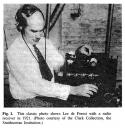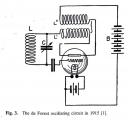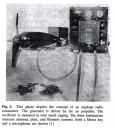APRIL 2011 HISTORY
Scanning the Past: A History of Electrical Engineering from the Past
Submitted by Marc Bell, Editor
Copyright 1997 IEEE. Reprinted with permission from the IEEE publication, “Scanning the Past” which covers a reprint of an article appearing in the Proceedings of the IEEE Vol. 85, No. 3, March 1997.
Lee de Forest and the Amplifying Audion
Seventy-five years ago this month, the INSTITUTE OF RADIO ENGINEERS (IRE) awarded its Medal of Honor to Lee de Forest as recognition for his invention of the three-electrode amplifier and his other contributions to radio. In 1946 he received the Edison Medal of the American Institute of Electrical Engineers (AIEE) and the citation mentioned the profound technical and social consequences of the grid-controlled vacuum tube which he had intro¬duced.  Known for having a rather flamboyant personality, de Forest (shown in Fig. 1) was both an entrepreneur and a prolific inventor who received more than 300 patents.
Known for having a rather flamboyant personality, de Forest (shown in Fig. 1) was both an entrepreneur and a prolific inventor who received more than 300 patents.
De Forest was born in Council Bluffs, IA, in 1873, the son of a Congregational minister. In 1879, the family moved to Talladega, AL, where his father served as president of Talladega College. After attending a college preparatory school in Massachusetts for two years, de Forest enrolled at the Sheffield Scientific School at Yale University in 1893, where he graduated in 1896. He went on to earn a doctoral degree from Yale in 1899 with a dissertation on standing waves produced by Hertzian waves on an open-ended transmission line. His first employment after college was in the Dynamo Department of the Western Electric Company in Chicago. He experimented with wireless communication in his spare time and developed a device he called a responder as an alternative to the coherer as a detector of wireless waves. He left Western Electric in 1901 and worked as an editor for the Western Electrician and as a part-time teacher until early in 1902 when he organized the de Forest Wireless Telegraphy Company. His company gained publicity from public demonstrations of wireless communication and the award of a gold medal for the best wireless system at the 1904 World’s Fair in St. Louis. The U.S. Navy also began to purchase some of the radio apparatus manufactured by the de Forest Company.
In 1906, de Forest filed a patent application on a wireless detector which he called an audion and which, in its initial form, was a two-electrode device. He presented a technical paper at an October 1906 ATEE meeting, “The Audion: A New Receiver for Wireless Telegraphy,” and commented that in all this work, a bewildering host of new and puzzling phenomena is continually encountered. He anticipated that the audion would provide “… rich fields for study to the physicist and delight to the practical man.”
In January 1907 he applied for a patent on a three-electrode audion in which one electrode consisted of a control grid inside the tube. The following month he organized a new company, the De Forest Radio Telephone Company. During 1908 he staged a radio broadcast from the Eiffel Tower in Paris, France, which was received as far as 500 miles from the transmitter.
De Forest served as president of the Society of Wireless Telegraph Engineers and became a charter member of the
IRE when it was formed in May 1912. By that time he was employed as a research engineer by the Federal Telegraph Company and his paper “Recent Developments in the Work of the Federal Telegraph Company” appeared in the first issue of the PROCEEDINGS OF THE IRE in January 1913. With the assistance of his friend, John S. Stone, de Forest approached the American Telephone and Telegraph Company (AT&T) in October 1912 about selling rights to use the audion as a telephone amplifier. The negotiations led to an initial payment of $50 000 in July 1913 and de Forest received an additional $340 000 from AT&T by March 1917. In March 1914, he published an IRE paper, “The Audion-Detector and Amplifier,” in which he reported that the audion now enjoyed widespread use. Several examples of audion circuits of this era are shown in Figs. 2-4.
 In October 1916, de Forest began broadcasting music from phonograph records five nights a week using a 250 W transmitter in New York City. The music was heard as far away as Mansfield, OH, and on one occasion, a dance was held in Morristown, NJ, using music broadcast from the de Forest radio station. At the time, he predicted that radio would especially benefit rural areas by providing news as well as
In October 1916, de Forest began broadcasting music from phonograph records five nights a week using a 250 W transmitter in New York City. The music was heard as far away as Mansfield, OH, and on one occasion, a dance was held in Morristown, NJ, using music broadcast from the de Forest radio station. At the time, he predicted that radio would especially benefit rural areas by providing news as well as  entertainment. By 1918, the de Forest company had developed an experimental radiophone transmitter for use in airplanes with its power provided by a generator driven by an air propeller (Fig. 5). During the 1920’s, de Forest worked on the development of talking motion pictures and also became interested in television. He served as president of the IRE in 1930 and, in his presidential address, called radio a young giant which had attained maturity with astonishing speed. However, he expressed dismay at excesses in radio advertising and claimed that the public was becoming nauseated by the quality of many of the present programs. He referred to television as a sleeping giant which still was in its infancy but deserved close attention as it developed. De Forest died in June 1961 at age 87.
entertainment. By 1918, the de Forest company had developed an experimental radiophone transmitter for use in airplanes with its power provided by a generator driven by an air propeller (Fig. 5). During the 1920’s, de Forest worked on the development of talking motion pictures and also became interested in television. He served as president of the IRE in 1930 and, in his presidential address, called radio a young giant which had attained maturity with astonishing speed. However, he expressed dismay at excesses in radio advertising and claimed that the public was becoming nauseated by the quality of many of the present programs. He referred to television as a sleeping giant which still was in its infancy but deserved close attention as it developed. De Forest died in June 1961 at age 87.
REFERENCES
[ 1 ] A.M. Goldsmith, Radio Telephony. New York: Wireless Press,
1918. [2] J. Zenneck, Wireless Telegraphy. New York: McGraw-Hill,
1915. James E. Brittain
